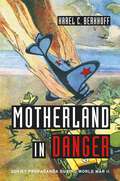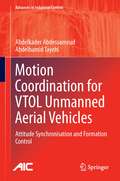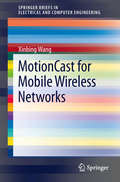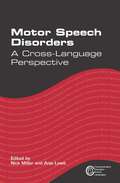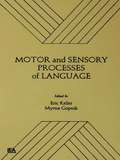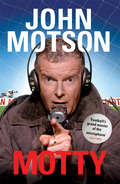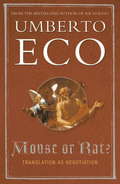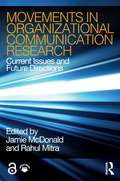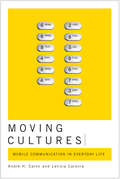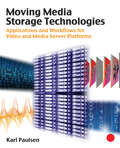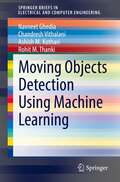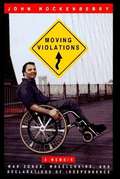- Table View
- List View
Most Likely to Succeed at Work: How to Get Ahead at Work Using Everything You Learned in High School
by Jack Dougherty Wilma DavidsonAs Kurt Vonnegut once said, "True terror is to wake up one morning and discover that your high school class is running the country."When it comes down to it, work--with its know-it-alls, gossips, and brown-noser--is a lot like high school. This clever and useful book helps readers identify and better communicate with these and other common types we all remember from the days when report cards, not business reports, were our concern, and when the big social event was the prom, not the company picnic.You don't need to dig out your yearbook to get a glimpse of these types--just take a look around your office: the Teacher's Pet, the Player, the Cheerleader, the Go-Getter, the Underachiever, the Class Clown, and many more.With wit and uncanny accuracy, corporate coaches Wilma Davidson and Jack Dougherty outline all the members of the "class," offering tips on working efficiently with each type, whether they're your boss, your client, or a colleague. The book also delivers advice on handling authority, conformity, looks, popularity, "sex education," and other indignities from high school that live on in the workplace.Whether you're still the same as you were in high school, a combination of types, or a reformed Rebel turned Class President, you will delight in and learn from this unique guide.
Mostly What God Does: Reflections on Seeking and Finding His Love Everywhere
by Savannah GuthrieGuthrie persuasively renders the evolution of a hard-won religious belief that makes room for imperfection and "does not require us to ignore... the sorrows we experience or the unjustness we see but to believe past it." This openhearted offering inspires. - Publishers WeeklyMostly what God does is love you.If we could believe this, really believe this, how different would we be? How different would our lives be? How different would our world be?If you ever struggle with your connection to God (or whether you even feel connected to a faith at all!), you're not alone. Especially in our modern world, with its relentless, never-ending news cycle, we can all grapple with such questions. Do we do that alone, with despair and resignation? Or do we make sense of it with God, and with hope? In these uncertain times, could believing in the power of divine love make the most sense?In this collection of essays, Savannah Guthrie shares why she believes it does. Unspooling personal stories from her own joys and sorrows as a daughter, mother, wife, friend, and professional journalist, the award-winning TODAY show coanchor and New York Times bestselling author explores the place of faith in everyday life.Sharing hard-won wisdom forged from mountaintop triumphs, crushing failures, and even the mundane moments of day-to-day living, Mostly What God Does reveals the transformative ways that belief in God helps us discover real hope for this life and beyond.A perfect companion to your morning cup of coffee, this incisive volume—not a memoir but a beautiful tapestry of reflections crafted as a spiritual manual—includes:a fresh, biblically rooted look at six essentials of faith: love, presence, grace, hope, gratitude, and purpose;an honest exploration of questions, doubts, and fears about the love of God;a dose of encouragement for the faith-full, the faith-curious, and the faith-less; and…and much more. This deeply personal collection is designed to engage the practical ways that God loves you—not just the world, but you—and to inspire you to venture down a path of faith that is authentic, hopeful, destiny-shaping, and ultimately life-changing.
Motherhood in the Media: Infanticide, Journalism, and the Digital Age (Routledge Research in Cultural and Media Studies)
by Barbara BarnettThis book examines contemporary media stories about women who kill their children. By analyzing media texts, motherhood blogs, and journalistic interviews, the book seeks to understand better maternal violence and the factors that lead women to harm their children. The central thesis of this book is that media practices have changed dramatically during the past 50 years, as has society’s views on "appropriate" feminine behavior, yet definitions of characteristics of good mothers remain largely defined by 1950s sit coms, Victorian ideals, and Christian theology. The book contends that in spite of media saturation in American society, and the media’s increased opportunities to tell complex and nuanced stories, news media narratives continue to situate maternal violence as rare, unfathomable, and unpredictable. The news media’s shift in focus—from public service to profit-making industry—has encouraged superficial coverage of maternal violence as reporters look for stories that sell, not stories that explain. Motherhood blogs, in contrast, offer an opportunity for women to tell their own stories about motherhood, based on experience. Interviews with journalists offer insights into how the structure of their jobs dictates media coverage of this intimate form of violence.
Motherland in Danger
by Karel C. BerkhoffMuch of the story about the Soviet Union’s victory over Nazi Germany has yet to be told. In Motherland in Danger, Karel Berkhoff addresses one of the most neglected questions facing historians of the Second World War: how did the Soviet leadership sell the campaign against the Germans to the people on the home front? For Stalin, the obstacles were manifold. Repelling the German invasion would require a mobilization so large that it would test the limits of the Soviet state. Could the UR marshal the manpower necessary to face the threat? How could the authorities overcome inadequate infrastructure and supplies? Might Stalin’s regime fail to survive a sustained conflict with the Germans? Motherland in Danger takes us inside the Stalinist state to witness, from up close, its propaganda machine. Using sources in many languages, including memoirs and documents of the Soviet censor, Berkhoff explores how the Soviet media reflected-and distorted-every aspect of the war, from the successes and blunders on the front lines to the institution of forced labor on farm fields and factory floors. He also details the media’s handling of Nazi atrocities and the Holocaust, as well as its stinting treatment of the Allies, particularly the United States, the UK, and Poland. Berkhoff demonstrates not only that propaganda was critical to the Soviet war effort but also that it has colored perceptions of the war to the present day, both inside and outside of Russia.
Motherless Tongues: The Insurgency of Language amid Wars of Translation
by Vicente L. RafaelIn Motherless Tongues, Vicente L. Rafael examines the vexed relationship between language and history gleaned from the workings of translation in the Philippines, the United States, and beyond. Moving across a range of colonial and postcolonial settings, he demonstrates translation's agency in the making and understanding of events. These include nationalist efforts to vernacularize politics, U.S. projects to weaponize languages in wartime, and autobiographical attempts by area studies scholars to translate the otherness of their lives amid the Cold War. In all cases, translation is at war with itself, generating divergent effects. It deploys as well as distorts American English in counterinsurgency and colonial education, for example, just as it re-articulates European notions of sovereignty among Filipino revolutionaries in the nineteenth century and spurs the circulation of text messages in a civilian-driven coup in the twenty-first. Along the way, Rafael delineates the untranslatable that inheres in every act of translation, asking about the politics and ethics of uneven linguistic and semiotic exchanges. Mapping those moments where translation and historical imagination give rise to one another, Motherless Tongues shows how translation, in unleashing the insurgency of language, simultaneously sustains and subverts regimes of knowledge and relations of power.
Mothers & Murderers: A True Story of Love, Lies, Obsession . . . And Second Chances
by Katherine Ellison&“[Weaves] together her own story and a stranger-than-fiction true-crime tale…gripping prose that by turns is tragic and hilarious.&”—Stephen Hinshaw, author of Another Kind of Madness This remarkable memoir by a Pulitzer Prize- and Polk Award-winning journalist takes readers on a wild, tragicomic ride from the criminal courtrooms of California&’s Silicon Valley to the Himalayan mountains of Pakistan to the deserts of Ethiopia. In delightful, insightful prose, Katherine Ellison reflects on her mistakes and her triumphs as she reveals the stories of how her career almost ended before it began, how she nearly missed marrying the love of her life, and how she unwittingly got drawn into a bizarre murder case. Rich in drama and self-reflection, replete with unique characters—including two bumbling hitmen, a rodeo-riding prosecutor, a flamboyant Beverly Hills defense attorney, and a charismatic stay-at-home mother-of-three who is keeping outrageous secrets—Mothers & Murderers is like a mashup of Fargo and Eat, Pray, Love—a memoir to make you laugh, cry, and think. &“In what she&’s authentically dubbed a &‘true-crime memoir, Katherine Ellison brings to bear the demons of her own past, her considerable chops as a reporter, and her willingness to plunge into the psychological depths. What she created is a dark jewel. The reader cannot look away.&”—Jacquelyn Mitchard, New YorkTimes-bestselling author of The Deep End of the Ocean &“Mothers and Murderers is like nothing else I&’ve ever read, and I mean that in the best possible way…Katherine Ellison captivatingly describes a young woman's path from blind impulse to wisdom…she makes an ultra-strong case for the examined life, shedding light on the lies we tell ourselves and others—and the hard work involved in taking responsibility for yourself.&”—Stephen Hinshaw, author of Another Kind of Madness
Motion Coordination for VTOL Unmanned Aerial Vehicles: Attitude Synchronisation and Formation Control
by Abdelhamid Tayebi Abdelkader AbdessameudMotion Coordination for VTOL Unmanned Aerial Vehicles develops new control design techniques for the distributed coordination of a team of autonomous unmanned aerial vehicles. In particular, it provides new control design approaches for the attitude synchronization of a formation of rigid body systems. In addition, by integrating new control design techniques with some concepts from nonlinear control theory and multi-agent systems, it presents a new theoretical framework for the formation control of a class of under-actuated aerial vehicles capable of vertical take-off and landing. Several practical problems related to the systems' inputs, states measurements, and restrictions on the interconnection topology between the aerial vehicles in the team are addressed. Worked examples with sufficient details and simulation results are provided to illustrate the applicability and effectiveness of the theoretical results discussed in the book. The material presented is primarily intended for researchers and industrial engineers from robotics, control engineering and aerospace communities. It also serves as a complementary reading for graduate students involved in research related to flying robotics, aerospace, control of under-actuated systems, and nonlinear control theory
MotionCast for Mobile Wireless Networks
by Xinbing WangMotionCast for Mobile Wireless Networks provides an overview on the research for mobile ad-hoc networks regarding capacity and connectivity. Wireless ad-hoc networks are useful when there is a lack of infrastructure for communication. The proposed notion "MotionCast" is for the capacity analysis of multicast in MANET. A new kind of connectivity (k;m)-connectivity, is also defined, and its critical transmission range for i.i.d. (independently and identically distributed) and random walk mobility models are derived respectively. This book also investigates the related issues of connectivity in mobile and static circumstances. In addition, it provides a survey of the capacity scaling research, which gives a good summary of this field.
Motivated Resumes and LinkedIn Profiles: Insight, Advice, and Resume Samples Provided by Some of the Most Credentialed, Experienced, and Award-Winning Resume Writers in the Industry (The Motivated Series #5)
by Brian E. Howard<i>Motivated Resumes and LinkedIn Profiles</i> is unlike any resume or LinkedIn profile book ever written! It gives you unprecedented insight and advice from over a dozen of the most credentialed, experienced, and award-winning resume and LinkedIn profile writers in the industry. <p>It contains over 180 pieces of sage advice quoted throughout the book. You will learn how these writers create impactful resumes and LinkedIn profiles that will stand out, get you interviews, and job offers! Get inside the minds of these writers. Learn how they think about keywords, titling, branding, accomplishments, format, color, design, and a host of other resume writing and LinkedIn profile considerations as they create stunning resumes and winning LinkedIn profiles. <p>Some say that <i>Motivated Resumes and LinkedIn Profiles</i> reveals too many secrets of the resume writing industry! Become an “insider” and learn the secrets from some of the very best.</p>
Motor Speech Disorders
by Anja Lowit Nick MillerMotor speech disorders are a common accompaniment of a whole range of neurological conditions, from stroke, brain injury and Parkinson's disease through to many rarer conditions. This book aims to aid understanding of the nature of motor speech disorders from a cross-language perspective, in contrast to the largely English-centric nature of research and practice recommendations to date. The book looks not just at how these motor speech disorders are assessed and treated in other countries, but also examines how underlying speech impairments differ according to the language someone speaks. The book studies the underlying neurological, neurophysiological and neurophonetic characteristics of motor speech disorders in different language contexts, and discusses the implications these have for clinical rehabilitation. This significantly adds to debates around the theoretical understanding and clinical management of motor speech disorders.
Motor and Sensory Processes of Language (Neuropsychology and Neurolinguistics Series)
by Eric Keller Myrna GopnikPublished in 1987, Motor and Sensory Processes of Language is a valuable contribution to the field of Cognitive Psychology.
Motorworld
by Jeremy ClarksonJeremy Clarkson invites us to Motorworld, his take on different cultures and the cars that they drive.There are ways and means of getting about that don't involve four wheels, but in this slice of vintage Clarkson, Jeremy isn't much interested in them.Back in 1996, he took himself off to twelve countries (okay, eleven - he goes to America twice) in search of the hows, whys and wherefores of different nationalities and their relationships with cars. There were a few questions he needed answers to:* Why, for instance, is it that Italians are more interested in looking good than looking where they are going?* Why do Indians crash a lot?* How can an Arab describe himself as 'not a rich man' with four of the world's most expensive cars in his drive? * And why have the otherwise neutral Swiss declared war on the car?From Cuba to Iceland, Australia to Vietnam, Japan to Texas, Jeremy Clarkson tells us of his adventures on and off four wheels as he seeks to discover just what it is that makes our motorworld tick over. _____________Praise for Jeremy Clarkson:'Brilliant . . . laugh-out-loud' Daily Telegraph'Outrageously funny . . . will have you in stitches' Time Out'Very funny . . . I cracked up laughing on the tube' Evening Standard
Motty: Forty Years in the Commentary Box
by John MotsonFrom Ronnie Radford to Wayne Rooney, John Motson's knowledge and passion for football are unrivalled. In Motty, he shares his story for the first time and guides us through a career which has spanned forty years and over 2,000 matches. From reporting on the exploits of the giant-killing Hereford team in the 1972 FA Cup that made his name on Match of the Day, to the estimated twenty-million viewers who tuned in to his commentary on England's match with Portugal at the 2006 World Cup, Motson's time in the commentary box has delivered some unforgettable anecdotes. In dozens of fascinating behind-the-scenes stories, we hear about the greatest football matches he has watched and the greatest players and managers he has been privileged to know. Many of them are football icons; Bill Shankly, Alex Ferguson, Brian Clough, Alf Ramsey, and Matt Busby, amongst countless others.Motty is essential reading for anyone who has grown up with the undisputed voice of football.
Mouse or Rat?: Translation As Negotiation
by Umberto Eco'Translation is always a shift,not between two languages but between two cultures. A translator must take into account rules that are not strictly linguistic but, broadly speaking, cultural.' Umberto Eco is of the world's most brilliant and entertaining writers on literature and language. In this accessible and dazzling study, he turns his eye on the subject of translations and the problems the differences between cultures can cause. The book is full of little gems about mistranslations and misunderstandings.For example when you put 'Studies in the logic of Charles Sanders Peirce' through an internet translation machine, it becomes 'Studies in the logic of the Charles of sandpaper grinding machines Peirce'. In Italian 'ratto' has no connotation of 'contemptible person' but denotes speed ('you dirty rat' could take on a whole new meaning!) What could be a weighty subject is never dull, fired by Eco's immense wit and erudition, providing an entertaining read that illuminates the process of negotation that all translators must make.
Mouse or Rat?: Translation as Negotiation
by Prof Umberto EcoFrom the world-famous author of THE NAME OF THE ROSE, an illuminating and humorous study on the pleasures and pitfalls of translation.'Translation is always a shift, not between two languages but between two cultures. A translator must take into account rules that are not strictly linguistic but, broadly speaking, cultural.'Umberto Eco is of the world's most brilliant and entertaining writers on literature and language. In this accessible and dazzling study, he turns his eye on the subject of translations and the problems the differences between cultures can cause. The book is full of little gems about mistranslations and misunderstandings.For example when you put 'Studies in the logic of Charles Sanders Peirce' through an internet translation machine, it becomes 'Studies in the logic of the Charles of sandpaper grinding machines Peirce'. In Italian 'ratto' has no connotation of 'contemptible person' but denotes speed ('you dirty rat' could take on a whole new meaning!)What could be a weighty subject is never dull, fired by Eco's immense wit and erudition, providing an entertaining read that illuminates the process of negotiation that all translators must make.
Move On: Adventures in the Real World
by Linda EllerbeeEllerbee gives details on how she moved from working with ABC to CNN.
Movement for Actors
by Nicole PotterTeachers and practitioners offer actors, directors, and students both practical suggestions and inspiration on how to tell the story through the body. Body basics, beyond glove and fan, and schools of thought are among the themes.
Movements in Organizational Communication Research: Current Issues and Future Directions
by Jamie McDonald Rahul MitraMovements in Organizational Communication Research is an essential resource for anyone wishing to become familiar with the current state of organizational communication research and key trends in the field. Seasoned organizational communication scholars will find that the book provides unique insights by way of the intergenerational dialogue that is found in the book, as well as the contributors’ stories about their scholarly trajectories. Those who are new to the field will find that the book enables them to familiarize themselves with the field and become a part of the organizational communication scholarly community in an inviting and accessible way. Key features of the book include: A review of current issues and future directions in 13 topical areas of organizational communication research. Intergenerational dialogue and collaboration between both established and emerging scholars in their specialty areas. Reflections by the authors on their scholarly trajectories and how they became a part of the field. Discussion questions at the end of each chapter that prompt reflections and debate. The book also features online resources for instructors: Sample course syllabus Suggested case studies from the book Cases in Organization and Managerial Communication to align with this book’s chapters The book is recommended as the anchor text for introductory graduate-level courses and upper-level undergraduate courses in organizational communication. It is also an excellent supplementary text for advanced doctoral-level courses in organizational communication, and courses in related fields such as organization studies, organizational behavior, and management.
Moving Beyond Academic Discourse: Composition Studies And The Public Sphere
by Christian R. WeisserMoving student writing beyond academic discourse and into larger public spheres is a difficult task, but Christian R. Weisser’s study challenges composition instructors to do just that. This highly accessible book does what no other study has attempted to do: place the most current, cutting-edge theories and pedagogies in rhetoric and composition in their intellectual and historical contexts, while at the same time offering a unique, practical theory and pedagogy of public writing for use both inside and outside of the classroom. By positing a theory of the public for composition studies, one which envisions the public sphere as a highly contested, historically textured, multilayered, and sometimes contradictory site, Weisser offers a new approach to the roles that compositionists might assume in their attempts to initiate progressive political and social change. After first providing a historical context that situates composition’s recent interest in public writing, Weisser next examines recent theories in composition studies that consider writing an act of social engagement before outlining a more complex theory of the public based on the work of Jürgen Habermas. The resulting re-envisioning of the public sphere expands current conversations in rhetoric and composition concerning the public. Weisser concludes with a holistic vision that places greater political and social import on addressing public issues and conversations in the composition classroom and that elucidates the role of the public intellectual as it relates specifically to compositionists in postmodern society.
Moving Cultures
by Letizia Caronia André H. CaronAndré Caron and Letizia Caronia look at teenagers' use of text messaging to chat, flirt, and gossip. They find that messaging among teens has little to do with sending shorthand information quickly. Instead, it is a verbal performance through which young people create culture. Moving Cultures argues that teenagers have domesticated and reinterpreted this technology.
Moving From Your Associate To Your Baccalaureate Nursing Degree
by Nancy DuphilyMoving from Your Associate to Your Baccalaureate Nursing Degree is designed to welcome and celebrate the experience, knowledge, and expertise practicing nurses bring to the academic table as they pursue a baccalaureate degree in nursing. The book aligns with Institute of Medicine competencies and emphasizes leadership and management, ethics and decision-making, critical thinking, evidence-based practice, caring, collaboration, communication, and self-reflective skills, all supported by literature and practice examples.
Moving Media Storage Technologies: Applications & Workflows for Video and Media Server Platforms
by Karl PaulsenComplex media storage computer systems are employed by broadcasters, digital cinemas, digital signage, and other business and entertainment venues to capture, store and retrieve moving media content on systems that will preserve the original integrity of the content over time and technological transition. This book provides detailed information related to the concepts, applications, implementation and interfaces of video file servers, intelligent storage systems, media asset management services, content distribution networks, and mission critical platforms. A tutorial and case example approach is taken to facilitate a thorough understanding of the technologies, using numerous illustrations, tables and examples. The text and appendices are designed to provide easy to access valuable reference and historical information. .A focus on the media serving concepts and principles employed at the enterprise level .Practical and technological summaries of the applications and linkages between media asset management and storage technologies for studio, television, and media production workflows .Illustrations, standards, tables, and practical summaries serve as handy reference tools
Moving Objects Detection Using Machine Learning (SpringerBriefs in Electrical and Computer Engineering)
by Rohit M. Thanki Ashish M. Kothari Navneet Ghedia Chandresh VithalaniThis book shows how machine learning can detect moving objects in a digital video stream. The authors present different background subtraction approaches, foreground segmentation, and object tracking approaches to accomplish this. They also propose an algorithm that considers a multimodal background subtraction approach that can handle a dynamic background and different constraints. The authors show how the proposed algorithm is able to detect and track 2D & 3D objects in monocular sequences for both indoor and outdoor surveillance environments and at the same time, also able to work satisfactorily in a dynamic background and with challenging constraints. In addition, the shows how the proposed algorithm makes use of parameter optimization and adaptive threshold techniques as intrinsic improvements of the Gaussian Mixture Model. The presented system in the book is also able to handle partial occlusion during object detection and tracking. All the presented work and evaluations were carried out in offline processing with the computation done by a single laptop computer with MATLAB serving as software environment.
Moving Target Defense II
by Sushil Jajodia Cliff Wang V. S. Subrahmanian Anup K. Ghosh X. Sean Wang Vipin SwarupOur cyber defenses are static and are governed by lengthy processes, e.g., for testing and security patch deployment. Adversaries could plan their attacks carefully over time and launch attacks at cyber speeds at any given moment. We need a new class of defensive strategies that would force adversaries to continually engage in reconnaissance and re-planning of their cyber operations. One such strategy is to present adversaries with a moving target where the attack surface of a system keeps changing. Moving Target Defense II: Application of Game Theory and Adversarial Modeling includes contributions from world experts in the cyber security field. In the first volume of MTD, we presented MTD approaches based on software transformations, and MTD approaches based on network and software stack configurations. In this second volume of MTD, a group of leading researchers describe game theoretic, cyber maneuver, and software transformation approaches for constructing and analyzing MTD systems. Designed as a professional book for practitioners and researchers working in the cyber security field, advanced -level students and researchers focused on computer science will also find this book valuable as a secondary text book or reference.
Moving Violations: War Zones, Wheelchairs and Declarations of Independence
by John HockenberryParaplegic newscaster Hockenberry speaks as a thought-provoking journalist, an insightful iconoclast and a man defined, but never confined by a wheelchair.



